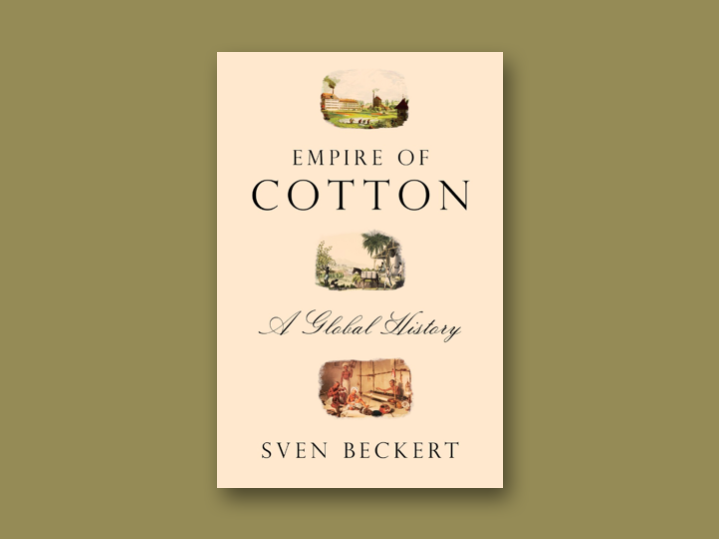Book Review: Empire of Cotton: A Global History
Sven Beckert, Empire of Cotton: A Global History, Knopf, $35, 640 pp., December 2014.
Sven Beckert’s Empire of Cotton: A Global History opens in 1860 at the annual meeting of the Manchester Chamber of Commerce, with a discussion in the most industrialized city in the world, between the most prosperous men, at the height of their power in agriculture, commerce, and industrial production. This scene aptly sets the stage for the reader; for it is here, in Great Britain, and with whom, the titans of industry, that Beckert spends the majority of the nearly 500 pages of his prodigious accomplishment. Starting with the earliest cultivation of the cotton plant, the development of the global cotton trade is traced through time and across the particular climatic regions of the world where it flourished. The first chapter concludes in the Middle Ages—a threshold moment during which this new material arrived in Europe, and began the inspiration of a number of labor-saving manufacturing techniques, which eventually led to what more closely resembled industrialized mass manufacturing.
Beckert’s tome, however, really takes off in the second chapter during the seventeenth century, when European nations rose to global power. Indeed, it is during this time that cotton truly becomes an international industry of large-scale cultivation and production. It becomes clear here that Beckert is a historian of capitalism, not of textiles, and therefore the majority of the book plays to his strengths. Specifically, his focus is on the economic, social, and political dimensions of international production. Through Beckert’s analysis, we come to learn how the industrialization of cotton was linked to the formation of the modern state. While generally thought to be separate from capitalism, the author connects this back to the determination among industrialists to maximize profits with minimal costs. He shows how cotton tycoons were often behind land expansion (such as the Louisiana Purchase) but also how governments then aided capital by regulating markets, enacting taxes, and otherwise protecting manufacturers.
An important takeaway here for a fashion historian is that the very evolution of modern nation-states relied upon the production of a strong national industry, which created both taxable wealth and jobs that stabilized the social and economic fabric of the state, and textiles often formed this backbone of emergent economies. Cotton in particular played an outsized role in the evolution of a global economy because of its seasonal trade that rested on the developing idea of credit: the advancement of the approximate value of the next year’s cotton crop. This kind of commission-intensive speculation relied on an increasing availability of information and the growing reliability of international infrastructure. The organization of militaristic, judicial, and administrative systems was created in part to control the complex transactions and transportation of this global commodity.
Indeed, Beckert’s core argument rests on what he calls “war capitalism,” which puts global industry necessarily at the cost of slavery, imperial expansion, the expropriation of both property and indigenous people, and the assertion of sovereignty over foreign lands. Different from a traditional history of capitalism as an evolving free enterprise of merchant investments and trade, his definition is inescapably reliant upon violence and how interconnected it was with the role that cotton played in the emergence of industrial capitalism.
The reach of this book is impressively global, which not only aptly rejects a conventional Eurocentric view of history, but attempts to answer why – and at what cost – European interests came to dominate global culture. The conventional (but evolving) focus on typically white and elite Western European cultures within the fields of dress history and fashion studies can certainly benefit from such a perspective. While there are other books that take on both the history of cotton and the difficult challenge of trying to define or explain capitalism, Empire of Cotton suggests the incredible reach of textile production into all levels of society around the world, and brings into stark relief the true cost of fashion – not just the way it facilitated incredible amounts of wealth, but the human capital it consumed along the way.
The book’s weakest elements are in the analysis of cotton on a more intimate level. Much like the under-represented history of textiles itself, domestic production and usage is glossed over, and the focus is on the more traditionally male-dominated areas of trade, commerce, and eventually, empire building. While Beckert acknowledges other sources in textile production, he focuses on cotton to the exclusion of other fibers, making it seem as though cotton itself were responsible for the development of most early textile production, instead of occurring in tandem with both animal and other plant fibers.
Furthermore, while Beckert acknowledges the typical division of gender in textile production – long thought of (and frequently dismissed) as “women’s work” – he overlooks the significant contribution of male labor to textile production in early societies, which then makes it more difficult to connect production of domestic goods in a cottage industry to a later expansion of the global market, and an increasing reliance on slave labor. Despite the focus on the massive demand for raw goods, little mention is given to final products, and how they were marketed, sold, or consumed. The book reads at times like the world was clamoring for the rapid rise of this unique plant, rather than the select few textile tycoons who took advantage of the fiber’s unique capacity for exploitation. Indeed, much of Beckert’s argument for the dominance of cotton in early societies is actually an argument for the importance of the production of textiles in general - an area that clearly needs more scholarship so that related fields (like the history of capitalism) might benefit from it.
Beckert’s frequent adage “imagine a world without cotton” actually suggests that one imagine a world without woven cloth. While clearly meant to elevate the significance of his product, from a fashion historian’s viewpoint, his exclusions only undercut his own claims for the universality of interest in this coveted consumer good, and the unique forces at play that led to cotton being an instrumental product in the rise of capitalism.
What Beckert does do, and well, is tell the tale of how this particular fiber’s manufacture, distribution, and consumption created a global economy, based on slavery and the forced colonization and exploitation of foreign lands and people. Any failure of the book is simply a reminder of its own value – that the importance of textiles has long been overlooked in the story of human history.



